GIGABYTE BRIX Pro: A First Look at the Intel i7-4770R with Iris Pro HD 5200
by Ganesh T S on January 7, 2014 8:00 PM EST
Gigabyte is targeting the BRIX Pro towards professional consumers with compute-intensive workloads. For general office use (including web browsing and light word processing work), systems such as the Core i5-based NUC we reviewed last week are more than enough. In order to bring out scenarios where the extra grunt provided by the Pro unit becomes necessary, we are presenting some real world benchmarks below. These are tasks carried out by workers where time in money, and the premium paid upfront for the better configuration is trivial compared to the time saved.
WinRAR Benchmark
We present two benchmarks using WinRAR. The first one involves decompressing a 4.36 GB split archive and recording the time taken to complete the process. This is a test of the CPU power as well as the storage subsystem.
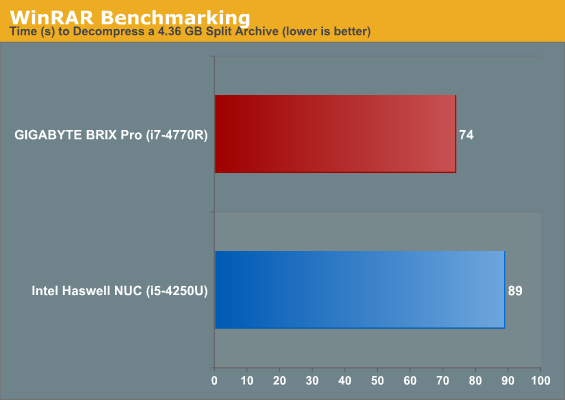
The graph below presents the internal WinRAR benchmark numbers. In this benchmark, the program takes compresses / decompresses random data in the RAM. This is a test of the CPU power as well as the DRAM capabilities.
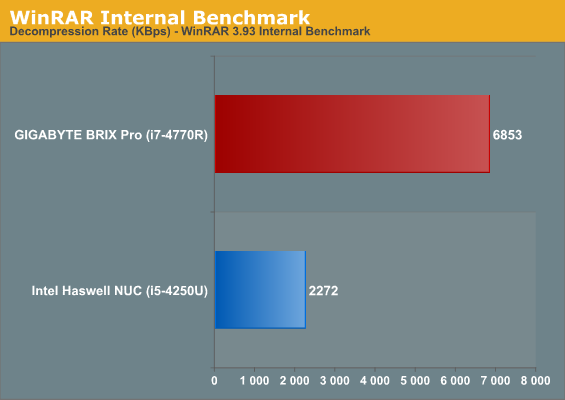
TrueCrypt Benchmark
As businesses (and even home consumers) become more security conscious, the importance of encryption can't be overstated. CPUs supporting the AES-NI instruction for accelerating the encryption and decryption processes have, till now, been the higher end SKUs. However, with Bay Trail, even the lowly Atom series has gained support for AES-NI. Both the i5-4250U and the i7-4770R have AES-NI instructions support. The TrueCrypt internal benchmark provides some interesting cryptography-related numbers to ponder. In the graph below, we can get an idea of how fast a TrueCrypt volume would behave in the two different systems.
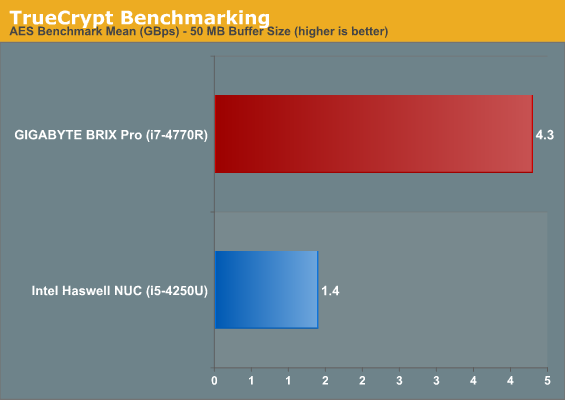
Agisoft PhotoScan
Agisoft PhotoScan is a commercial program that converts 2D images into 3D point maps, meshes and textures. The program designers sent us a command line version in order to evaluate the efficiency of various systems that go under our review scanner. The command line version has two benchmark modes, one using the CPU and the other using both the CPU and GPU (via OpenCL). The benchmark takes around 50 photographs and does four stages of computation:
Stage 1: Align Photographs
Stage 2: Build Point Cloud (capable of OpenCL acceleration)
Stage 3: Build Mesh
Stage 4: Build Textures
We record the time taken for each stage. Since various elements of the software are single threaded, others multithreaded, and some use GPUs, it is interesting to record the effects of CPU generations, speeds, number of cores, DRAM parameters and the GPU using this software.
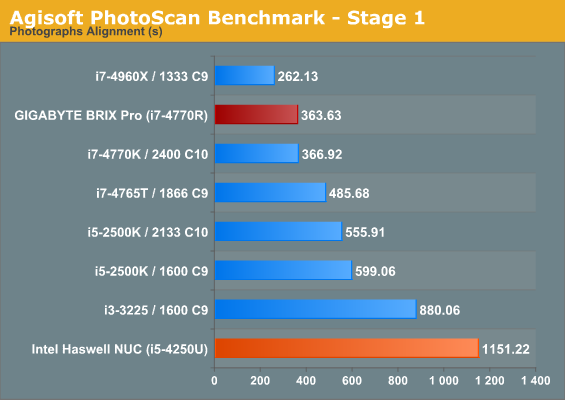
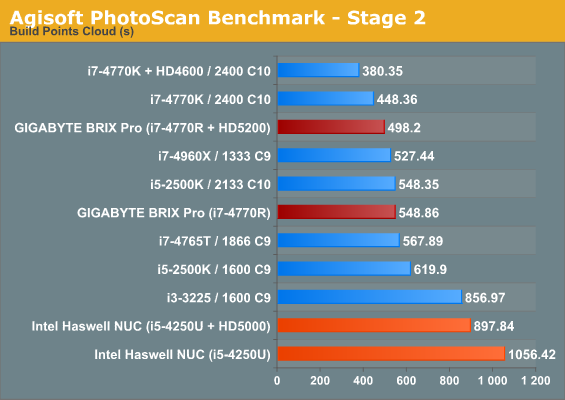

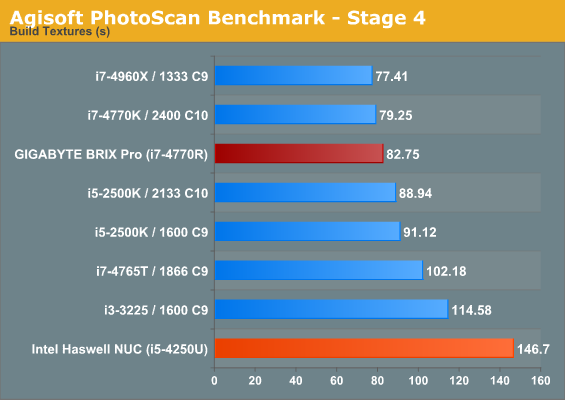
The second stage also reports the throughput rate of the CPU and GPU in million points per second. For the BRIX Pro, in the CPU only mode, we had a rate of 124.99 mp/s. Using OpenCL acceleration, the CPU and GPU had rates of 69.5 mp/s and 98.32 mp/s respectively. The corresponding numbers for the NUC were 68.36 mp/s, 20.39 mp/s and 78.59 mp/s.
Essentially a prosumer real-world test, we hope to put more of our systems under this benchmark in the future. Ian already has a large number of custom-built systems for which he will present benchmarks in his motherboard reviews.










98 Comments
View All Comments
johnny_boy - Friday, January 10, 2014 - link
Not too interesting really, unless you desperately need something this small with this much power, but I can't imagine who would. It's too loud and throttles. You can get a marginally larger ITX build with far better cooling, much quieter, and never throttles, and doesn't look as cheap.Laststop311 - Friday, January 10, 2014 - link
Shame about the noise level. Other than the noise this is an HTPC dream machine.boto - Friday, January 10, 2014 - link
I like Linux testing to be done. Also, please see how easily the fan can be replaced for a quieter one. I'm not interested in fanless cases since they're often bigger and very expensive.Andresen - Monday, January 13, 2014 - link
The homepage for Gigabye.com is not very accurate about the amount of eDRAM. The version for Great Britain says 128 MB (see http://uk.gigabyte.com/press-center/news-page.aspx... and the same announcement on the Danish page says 64 MB ( http://www.gigabyte.dk/media/13441 ).In any case the unit could be interesting for a small HPC setup. I hope there will be some computational tests that stress the memory bandwidth in the further coverage.
Ktracho - Tuesday, January 14, 2014 - link
It looks like my comment from a few days ago didn't get posted. I currently have a desktop computer and a small NAS box. Something like this could combine both while drastically reducing physical space and power consumption. Noise wouldn't be as critical as in a HTPC, provided it didn't make a lot of noise while performing light tasks, such as web browsing, e-mail, word processing, etc., which is the bulk of what I would do with it. I don't use my desktop PC very intensively, but there are times when I absolutely need to have it around, and being able to do more than just light tasks is definitely a plus. I'd look into using Windows 8.1 Pro under the included Hyper-V in combination with Linux or a second copy of Windows, with one VM for personal use and the other for the NAS side.As for HTPC, I'd prefer something that can also be used for gaming, so I'm thinking of taking over my daughter's mini-ITX box when she goes to college, and have one VM for HTPC use, and another VM running Windows with its own dedicated graphics card for gaming. It also has a blu-ray player, so I'd eventually be able to get rid of our PS3. In my situation, this box would not work so well for what I have in mind for HTPC.
oviano - Friday, January 17, 2014 - link
Is the noise really a huge issue I wonder, for HTPC use?Ok so maybe you need to reencode some video files or whatever from time to time and this will be presumably nice and quick (and noisy) with this vs say the NUC, but for general day-to-day use presumably it's not going to be pushed to the limit?
kgh00007 - Friday, January 17, 2014 - link
Any sign of part II yet? :-)DriesV - Saturday, January 18, 2014 - link
I just ordered mine. Couldn't wait for a final review. :-)Thermal performance under combined Prime95 and FurMark load is not very relevant, I think. You just KNOW that these units are not going to have the best cooling. The question is: will the cooling suffice for everyday (non-OC) usage? I strongly believe it will.
I'll be using mine as a networked render node (KeyShot). So I'm interested in thermal performance @ 100% CPU load in a real-life application.
jgstew - Sunday, January 19, 2014 - link
Is there a good reason for intel to release Iris Pro as OEM only? Are they worried about motherboard compatibility / specific tuning to take advantage of it, or perhaps worried about supply issues? I don't see why intel cannot release these parts at retail as well as OEM, at least eventually.lco45 - Monday, January 20, 2014 - link
Shame there's no micro format for graphics cards.I thought mITX would be a nice size reduction for my new system, but these NUC/BRIX form factor boxes are so much smaller than even the most compact mITX system.
If only there were system builder versions of these tiny pcs, especially with a mini GPU option, such as the mobile GPUs that come on gaming laptops.
Basically I want a gaming laptop without the laptop!